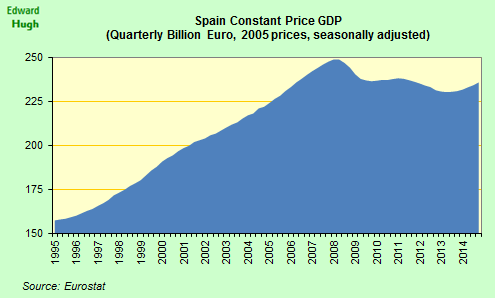Up to now the data in this regard has been rather anecdotal, like the big drop in cement output in Greece, but today we have a first real data reading (retail sales etc data for the relevant period will still be a little while arriving) in the shape of the Spanish Consumer Confidence Index. Over to Bloomberg:
Consumer confidence in Spain declined to a record low in September after the fallout from the U.S. subprime-mortgage slump pushed up borrowing costs worldwide.
The Official Credit Institute's index of consumer sentiment dropped to 80.2 from 86.5 in August, the institute said today on its Web site. That is the lowest reading in a series that started in 2004.
The cost of inter-bank loans jumped in August after European lenders disclosed losses in the U.S. mortgage market. That pushed up payments for Spanish homeowners who have variable-rate loans tied to the 12-month interbank lending rate for the euro region.
``Spain is heading for a marked slowdown and by mid-2008 we expect it to be growing at decidedly below-trend rates,'' Dominic Bryant, an economist at BNP Paribas SA in London, said in an e-mailed note.
The 12-month Euribor rate jumped to 72 basis points above the European Central Bank's benchmark interest rate this month, twice the average spread since the debut of the euro. In Spain, 95 percent of home loans have variable interest rates.
Here's the chart:

and here's the chart for the sub-components:

What can be seen from this chart is that all the components reached a peak this summer in April and May, in June and July they were all down, but only to the level of February/March, then from July onwards the whole thing starts to subside, and who knows if we have touched bottom yet, since all the forward indicators are a bit more positive, but my feeling is that that is rather an indication of the fact that people still don't appreciate the gravity of what is happening. It hasn't sunk in yet, and people are still expecting the housing market to pick up in a quite unexpected fashion. Spain could face a hard landing. If things continue to move at this speed it will get one.
Also service activity in Spain, which accounts for some 60 percent of the economy, posted its slowest expansion in almost two years in September, according to a separate survey of executives by NTC economics. The index fell to 52.4 from 53.5 in August.

A similar picture can be seen in the manufacturing PMI, although manufacturing accounts for a much smaller part of total economic activity in Spain than in some other European economies.

In the case of manufacturing, the rate of expansion has been slowing since June, although some reduction of activity is normal in the summer. It is the September reading which should give cause for concern here.
At the present time we are simply talking about a slowdown in the rate of expansion, but how far is this now away from an actual contraction. Not very, I would say.













No comments:
Post a Comment